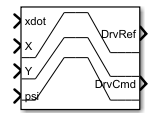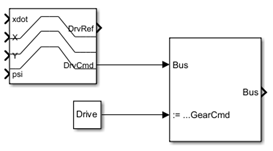Lane Change
Libraries:
Vehicle Dynamics Blockset /
Vehicle Scenarios /
Drive Cycle and Maneuvers
Description
The Lane Change block generates commands to conduct lane change maneuvers and adjusts the acceleration command according to the selected maneuver, after the vehicle reaches the target longitudinal velocity. Then, the block generates a lateral reference trajectory as a function of the longitudinal displacement. The block also generates signals indicating the left and right lane boundaries as a function of the specified track width.
Use the Lane change type, changeType parameter to select the desired lane change type.
| Action | Lane Change Type Setting |
|---|---|
Simulate a double-lane change. The block holds the acceleration constant. |
|
Simulate a lane change with obstacle avoidance. The block commands zero-acceleration. |
|
Simulate a lane change with obstacle avoidance for a truck-trailer. The block does not override the acceleration command. |
|
You must set the initial longitudinal position of the vehicle in your model to a reasonable distance from the gate and specify these block parameters to ensure the vehicle reaches the target velocity before arriving at the gate:
Inertial longitudinal position of gate entrance, XGate [m]
Longitudinal entrance velocity setpoint, velRef
Distance after target speed to begin reference, xStart [m]
Note
For information on the reference generator block used in the double-lane change reference application, see Reference Generator.
Ports
Input
Output
Parameters
References
[1] "Passenger cars — Test track for a severe lane-change manoeuvre." International Organization for Standardization. https://www.iso.org/standard/67973.html.
[2] "Passenger cars — Test track for a severe lane-change manoeuvre." International Organization for Standardization. https://www.iso.org/standard/57253.html.
[3] Trigell, Annika Stensson, et al. “Advanced Vehicle Dynamics of Heavy Trucks with the Perspective of Road Safety.” Vehicle System Dynamics, vol. 55, no. 10, Oct. 2017, pp. 1572–617. DOI.org (Crossref), https://doi.org/10.1080/00423114.2017.1319964.
[4] Fancher, P., and C. Winkler. “Directional Performance Issues in Evaluation and Design of Articulated Heavy Vehicles.” Vehicle System Dynamics, vol. 45, no. 7–8, July 2007, pp. 607–47. DOI.org (Crossref), https://doi.org/10.1080/00423110701422434.

